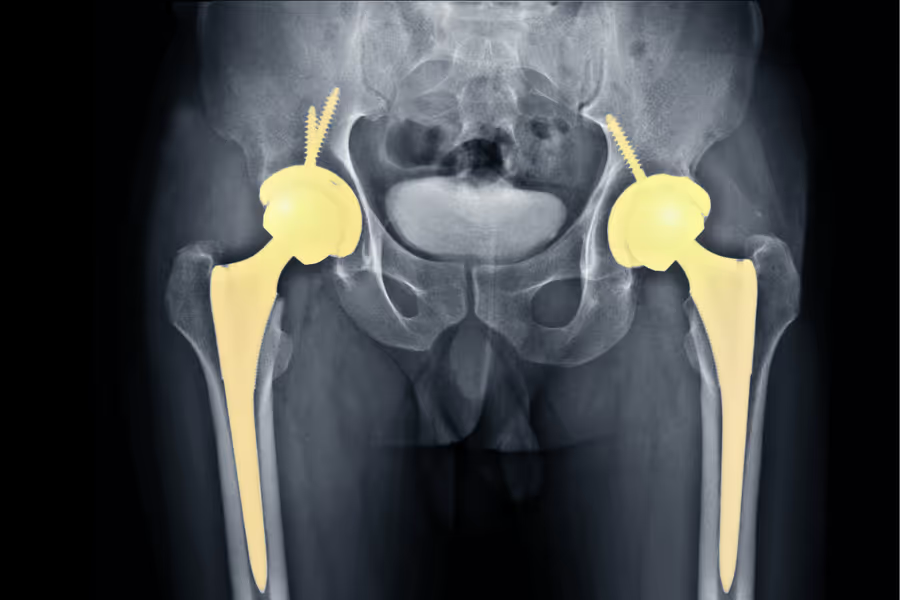If you’ve been told you need hip surgery, you’ve likely discovered there isn't just one way: anterior, posterior, lateral hip approach, robotic, resurfacing—but which is best?
The honest answer, backed by current research, is that there is no single “best” hip replacement method for everyone. Long‑term results are often similar across major hip surgery approaches. What matters most is:
- Your body and medical history
- The approach your surgeon knows best and performs most often
- The overall experience and volume of the surgical team
For an in-depth review, check out our Hip Replacement procedure page.

What Are the Main Hip Replacement Methods?
When people evaluate hip replacement methods, they’re usually comparing where the surgeon makes the incision and how they move the muscles to reach the joint.
The main hip surgery approaches are:
- Anterior hip replacement: incision at the front of the hip
- Posterior hip replacement: incision at the back of the hip
- Lateral hip approach: incision along the side of the hip
- Minimally invasive hip replacement: smaller incisions and muscle‑sparing techniques (can be anterior or posterior)
- Robotic-assisted hip replacement: using robotic tools to guide implant positioning
- Hip resurfacing: an alternative for select younger, active patients
Newer methods like minimally invasive and robotic-assisted hip replacement generally refine traditional approaches rather than replace them. They are tools and variations, not entirely new operations.
Comparison of Common Hip Replacement Approaches
*Early recovery varies a lot by patient, not just by approach.
What Is the Newest Hip Replacement Technique?
Right now, two of the most talked‑about “new” techniques are:
- Robotic-assisted hip replacement
- Personalized, minimally invasive approaches (often using imaging and planning software)
Potential benefits:
- More precise implant positioning
- Detailed pre‑operative planning
- May help in hips with unusual anatomy or previous surgery
Outcomes still depend heavily on the experience of the surgeon using the technology, but a 2025 meta-analysis found robotic-assisted total hip replacement significantly improved Forgotten Joint Scores (i.e. a questionnaire asking patients about awareness of the artificial joint post-surgery) and Oxford Hip Scores (i.e. standard questionnaire about pain and function post-surgery).
Think of robotics as a high‑tech tool in an experienced orthopedic surgeon’s hands, not a completely different operation. It's a refinement, not a revolution.
What Is the New Alternative to Hip Replacement?
A common question is whether there is a new alternative to hip replacement.
For a small, carefully selected group of people, that alternative is hip resurfacing:
- Instead of removing the top of the thigh bone, the surgeon reshapes and “caps” it with metal
- Often used for younger, active patients with strong bone and certain types of arthritis
- Can preserve more bone, which may be helpful if further surgery is needed later
However, hip resurfacing is not right for most patients, and it comes with its own set of potential hip replacement complications (for example, metal‑on‑metal wear).
If you’re interested, it’s important to speak with a surgeon who regularly performs hip resurfacing and can walk you through the risks and benefits.
Is One Hip Replacement Method Really Better?
When researchers compare anterior, posterior, and lateral hip approaches, they generally find:
- Similar long‑term pain relief and function
- Some differences in early recovery, but these usually even out over time
- Surgeon experience and case volume are strong predictors of outcome
Examples from research:
- Dislocation risk: Historically a bit higher in posterior approaches, but modern soft‑tissue repair and larger-head implants have dramatically reduced this difference.
- Incision size: Smaller incisions may look better cosmetically but don’t guarantee fewer complications or better long‑term function.
- Early mobility: Some studies show slightly faster early mobility with anterior hip replacement, but by 3–12 months, function scores are often similar between approaches.
For most people, the best hip replacement method is the one that,
- fits their anatomy and health, and
- their surgeon performs confidently and frequently.
Which Is Safer, Anterior or Posterior?
Patients often ask, “Is anterior hip replacement better than posterior?” Safety is rarely about the incision alone.
- Posterior hip replacement
- Historically associated with a slightly higher risk of dislocation
- Modern techniques (capsule repair, careful implant positioning) have greatly reduced this risk
- Extremely common and well‑studied, suitable for many body types
- Anterior hip replacement
- May allow fewer early movement restrictions and faster early mobility for some patients
- Carries its own specific risks, such as nerve irritation or wound‑healing challenges, especially in certain body shapes
- Requires a learning curve; safest when the surgeon is highly experienced with this approach
Across Canada, serious hip replacement complications are uncommon with both approaches when surgery is done by an experienced team.

What Is the Least Invasive Hip Replacement Procedure?
People often equate “less invasive” with “better,” but it’s more nuanced.
- Minimally invasive hip replacement usually means:
- Smaller skin incisions
- Techniques that spare or split rather than cut through muscles
- Can be done through either anterior or posterior approaches
A small incision does not automatically mean less pain, fewer complications, or a better long‑term result.
Trying to force a small incision in someone with complex anatomy can actually make surgery more difficult, which is not in the patient’s best interest.
The least invasive hip replacement procedure for you is the one that allows your surgeon to see and work safely, while respecting your tissues as much as possible.
Is Robotic Hip Replacement Better Than Traditional?
Robotic-assisted hip replacement can improve the precision of implant placement and alignment, especially in hips that are unusually shaped or previously operated on.
But it’s important to understand:
- Robotics is not a separate “method”; it’s a tool that can be applied to any major approach (anterior, posterior, lateral).
- Outcomes still depend primarily on the surgeon’s planning, judgment, and technical skill.
- Not every hospital or private clinic offers robotics, and it’s not required to achieve an excellent, long‑lasting hip.
For many patients, a “traditional” hip replacement by a high‑volume surgeon is just as effective as a robotic procedure.
How to Choose the Right Hip Replacement Method for You
Instead of starting with “Which method is best?”, a more helpful question is:
“Which approach makes sense for my body and this surgeon?”
Factors your surgeon considers:
- Anatomy and diagnosis: Hip shape, degree of arthritis, prior injuries or surgeries
- BMI and body shape: Which approach allows safest access
- Bone quality: Osteoporosis, deformities, or bone cysts
- Lifestyle and goals: Level of activity, type of work, sports you hope to return to
- Medical history: Heart or lung conditions, diabetes, medications like blood thinners
- Their expertise: Which approach they perform most often and with the best track record
In practice, surgeons tend to focus on body shape and arthritis pattern, and personal experience. Their familiarity with an approach often outweighs small theoretical advantages of a different method.

Questions to Ask Your Surgeon
To feel confident and involved in your care, consider asking:
- Which approach do you use most, and why?
- How many hip replacements do you perform per year?
- Am I a candidate for anterior, posterior, lateral, or minimally invasive hip replacement?
- Do you offer robotic-assisted hip replacement, and would it change my outcome?
- What complications are most relevant in my situation, and how do you minimize those risks?
- How long are hip replacement wait times here, and what are my options if I can’t wait that long?
These questions can help you compare surgeons and decide whether to remain in the public system, seek a second opinion, or explore private hip replacement in Canada.
If you are exploring your options for private surgical care, check out our directory which lists vetted Canadian orhopedic surgeons.
When Newer/ Robotic Techniques Make Sense
Newer or robotic‑assisted techniques may make particular sense if:
- You have complex anatomy (for example, previous fractures, deformity, or previous surgery)
- You and your surgeon want the highest possible precision in implant placement
- You’re treated in a centre that performs a high volume of robotic-assisted hip replacements and can show consistent results
They are helpful tools, but not essential for every patient.
What to Expect from Recovery (Any Method)
While early details of recovery can differ between approaches, there are common themes:
- Anterior hip replacement
- May come with fewer formal movement restrictions early on
- Some patients feel more comfortable walking without aids sooner
- Posterior hip replacement
- Sometimes includes temporary precautions to reduce dislocation risk (for example, avoiding certain hip positions)
- Most people regain similar function to anterior patients by a few months
In the long run, research shows similar function and satisfaction regardless of approach. What has a major impact is:
- Good physiotherapy and home exercises
- Following weight‑bearing and movement guidance
- Managing pain and swelling
- Gradually returning to daily activities
Recovery Timeline (Typical, Not Personalized)
- Week 1:
- In hospital or short‑stay unit, then home
- Walking with a walker or crutches
- Starting gentle exercises and blood clot prevention
- Weeks 2–6:
- Transitioning from walker to cane, then to unassisted walking as safe
- Increasing strength, balance, and confidence
- Many people resume light household tasks and short outings
- 3 months and beyond:
- Most patients return to low‑impact activities (walking, cycling, golf)
- Pain is significantly better than before surgery for the majority
- Improvements can continue for 6–12 months
Your surgeon or physiotherapist will give a personalized plan based on your age, fitness, and any other health conditions.

Your Next Steps Toward Hip Pain Relief
There is no single “best” hip replacement method for everyone. Instead:
- The “best” method is the one that fits your anatomy and goals
- It is delivered by a skilled, experienced surgeon who uses that approach regularly
- Newer tools like robotic assistance are valuable in some cases, but they don’t replace good surgical judgment
If you’re in Canada and facing long hip replacement wait times or you’re caring for a loved one who is struggling, you don’t have to feel stuck.
Surgency helps you:
- Explore private hip replacement in Canada
- Compare surgeons by location, price, qualifications, and experience
- Understand estimated wait times and costs up front
- Book consultations directly with vetted providers
Explore private hip replacement options on Surgency
You can review options, ask the right questions, and choose the hip replacement techniques and surgeon that get you back to your life—without waiting years in pain.




